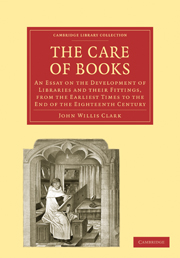 The Care of Books
The Care of Books In the last chapter I attempted to describe the way in which the Monastic Orders provided for the safe keeping of their books, so long as their collections were not larger than could be accommodated in a press or presses in the cloister, or in the small rooms used by the Cistercians for the same purpose. I have now to carry the investigation a step farther, and to shew how books were treated when a separate library was built.
It must not be supposed that an extensive collection of books was regarded as indispensable in all monastic establishments. In many Houses, partly from lack of funds, partly from an indisposition to study, the books were probably limited to those required for the services and for the daily life of the brethren. In other places, on the contrary, where the fashion of book-collecting had been set from very early days, by some abbat or prior more learned or more active than his fellows, and where brethren in consequence had learnt to take a pride in their books, whether they read them or not, a large collection was got together at a date when even a royal library could be contained in a single chest of very modest dimensions. For instance, when an inventory of the possessions of the Benedictine House of S. Riquier near Abbeville was made at the request of Louis le Débonnaire in 831 a.d., it was found that the library contained 250 volumes and a note at the end of the catalogue informs us that if the different treatises had been entered separately, the number of entries would have exceeded five hundred, as many books were frequently bound in a single volume.
To save this book to your Kindle, first ensure [email protected] is added to your Approved Personal Document E-mail List under your Personal Document Settings on the Manage Your Content and Devices page of your Amazon account. Then enter the ‘name’ part of your Kindle email address below. Find out more about saving to your Kindle.
Note you can select to save to either the @free.kindle.com or @kindle.com variations. ‘@free.kindle.com’ emails are free but can only be saved to your device when it is connected to wi-fi. ‘@kindle.com’ emails can be delivered even when you are not connected to wi-fi, but note that service fees apply.
Find out more about the Kindle Personal Document Service.
To save content items to your account, please confirm that you agree to abide by our usage policies. If this is the first time you use this feature, you will be asked to authorise Cambridge Core to connect with your account. Find out more about saving content to Dropbox.
To save content items to your account, please confirm that you agree to abide by our usage policies. If this is the first time you use this feature, you will be asked to authorise Cambridge Core to connect with your account. Find out more about saving content to Google Drive.